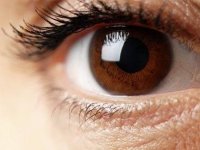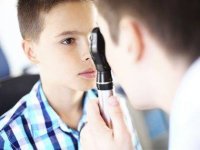J
Jeanh
Guest
 EHStock/iStock
EHStock/iStockDark eyes: Less likely to have macular degeneration
People with light-colored eyes had twice the risk of age-related macular degeneration of those with dark or intermediate iris colors, found a study of 171 participants published in the journal Clinical and Experimental Ophthalmology. “A dark iris blocks more ultraviolet light,” says optometrist Christopher Quinn, OD, secretary-treasurer of the American Optometric Association. “UV light is a risk factor for macular degeneration. Extra light that gets into the eyes of people with light-colored irises may cause them to have more retinal degeneration.”
 gilaxia/iStock
gilaxia/iStockDark eyes: Lower melanoma risk
Dark-colored irises might indicate you have a lower risk of skin cancer. In a study published in Cancer Epidemiology, Biomarkers & Prevention, researchers took DNA samples and gathered sun exposure data from nearly 500 white children, ages 6 to 10, for four years. Children with the blue-eye gene were more likely to develop moles compared to children without the gene. (The number of moles people develop during childhood can predict risk of melanoma in adulthood.) Other research has found that people with blue or green eyes are at greater risk of melanomas of the eye, likely because they have less light-absorbing pigment to shield the eyes from sun damage. But no matter what color your eye pigment, it’s always a good idea to protect your eyes with large sunglasses or UV-absorbent contact lenses, says Quinn.
 Squaredpixels/iStock
Squaredpixels/iStockLight eyes: More competitive
Australian researchers asked 336 participants of white European descent to complete questionnaires designed to measure personality factors. Agreeable factors were determined by how closely participants identified with statements such as “I make people feel at ease” or “I see myself as someone who is considerate and kind to almost everyone.” Those with dark eyes were more likely to be associated with words like “generosity, friendliness, and empathy” than light-eyed people, whose personalities were pegged less agreeable and more competitive. Though more research is needed, researchers suggest the results could have to do with evolutionary roots. Thousands of years ago, Northern Europeans may have found light-colored eyes exotic or more attractive and ideal for mating, possibly giving blue-eyed people a competitive edge.
 veronicagomepola/iStock
veronicagomepola/iStockDark eyes: Considered more trustworthy
In a study published in PLOS ONE, researchers asked 238 volunteers to rate photographs of people for trustworthiness. Overall, participants rated brown-eyed faces as more trustworthy than blue-eyed faces. However, when researchers digitally changed the eye colors, the ratings remained consistent. This led researchers to analyze the correlation between eye color and facial features. They discovered that men with dark eyes tend to have more additional trustworthy traits than those with light eyes (such as bigger mouths, broader chins, and bigger eyes—features that mirror how faces naturally express happiness.) More research is needed, especially to determine the link for women, who didn’t show the same correlation between trustworthiness and face shape.
 axelbueckert/iStock
axelbueckert/iStockLight eyes: Less likely to have vitiligo
In a University of Colorado School of Medicine study, researchers tracked nearly 3,000 people with vitiligo, an autoimmune disease in which a person’s immune system attacks healthy pigment cells and causes blotchy skin. Researchers identified 13 genes linked to a predisposition to vitiligo. They found that people with the disease were significantly less likely to have blue or gray eyes than those without it. Of the vitiligo patients, who were all of Non-Hispanic European ancestry, 43 percent had dark eyes, 30 percent had green or hazel eyes, and 27 percent had blue or gray eyes. This differed from typical eye color distribution among Americans of Non-Hispanic European descent, in which 52 percent have blue or grey eyes and only 27 percent have brown or tan eyes. Vitiligo patients are at higher risk for other autoimmune diseases such as lupus, type 1 diabetes, and thyroid disease.
 PeopleImages/iStock
PeopleImages/iStockDark eyes: Drink less *******
If your blue-eyed pals seem to drink more than you, this connection may actually have a scientific link. In a Georgia State University survey of 12,000 men and women, researchers found that people with light eyes drank markedly more ******* and were more likely to abuse it than people with dark eyes. But, why? Researchers hypothesize that it could be due to melanin, the pigment that makes eyes darker. Melanin is involved in electrical connections between brain cells. If the amount of melanin in the eye (dark-eyed people have more) correlates with the amount of melanin in the brain, it could mean dark-eyed people are more sensitive to stimuli like *******, which means they may get tipsy off less ******* than light-eyed people do. Still, more research is needed. “People with light irises drink more, that’s an undeniable conclusion of this study,” says Quinn. “What’s harder to say is whether it’s the iris color that determines if people drink or don’t drink. It shows an association, not a causal relationship.”
Attachments
-
You do not have permission to view the full content of this post. Log in or register now.